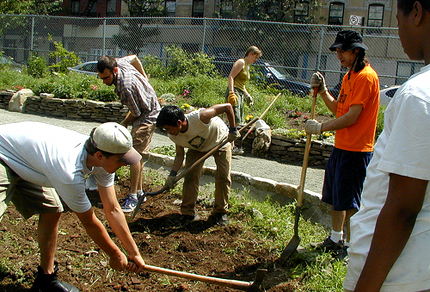Courtney Gross

Six months ago, Prison Health Services -- the private, for profit company that manages health care in 10 of the city's 11 jails -- got a raise.
The Tennessee-based corporation, which has a virtual monopoly on health care in prisons nationwide, saw its payments increase by more than 10 percent -- a figure that has been adjusted for inflation -- since its previous agreement with the city in 2005.
That boost, which city officials attribute to cost of living increases, came despite the company's failure to meet at least 15 percent of its performance standards set by the city's Department of Health and Mental Hygiene between 2006 and 2008. On several occasions, the company did not meet a quarter of its performance indicators, which include completing intake histories and conducting physical exams, according to quarterly review reports from the department.
Because of this poor performance, the city has fined Prison Health Services for the past three years in a row.
While many advocates agree that care on Rikers Island has improved since it was run by a private hospital a decade ago, others say the city's jails still do not provide quality health care. Whether it's a lack of leadership or the challenges of dealing with a transient, often mentally ill, population, quality health care is as isolated from Rikers' inmates as the island itself.
The Quality Gap
Prison Health Services just kicked off its third, three-year contract with the city's Department of Health and Mental Hygiene. The price tag: $366 million.
As part of that contract, the health department issues quarterly performance review reports, evaluating whether the corporation has substantially met or failed to meet certain health care criteria. The reviews measure the quality of women's health, asthma care, confidentiality, testing for sexually transmitted diseases and more.
The measurements are gleaned from a review of 9,000 records per quarter, said Louise Cohen, deputy commissioner for health care access and improvement at the Department of Health and Mental Hygiene. These records assess Prison Health's performance through 40 indicators, some of which are analyzed by a random sample.
In its last two years of service to the city, the time leading up to the contract renewal, Prison Health Services has continuously failed to meet a handful of city standards -- some more than others. In six of the eight quarters from January 2006 through December 2007, Prison Health Services did not properly follow up on certain HIV treatment testing. Some inmates, Cohen said, received follow-up tests several days late.
For five consecutive quarters, until mid-2007, the corporation did not meet standards for taking inmates' histories when they arrive at Rikers, skipping over parts of the mandatory paperwork, said Cohen. On average, Prison Health complied with the department's intake standards about 61 percent of the time during that period.
Now that the department is rolling out an electronic intake system, Cohen said, that process should run more smoothly. The Bloomberg administration requires that every inmate receive an intake physical within 24 hours of arrival on the island . According to the Mayor's Management Report, more than 89,000 intake exams were given in fiscal year 2007 -- that out of approximately 100,000 annual admissions.
For three out of four quarters in 2007, Prison Health also did not meet standards for follow-up care for inmates in segregated housing. Cohen said this was due to security concerns in one facility that may have skewed the entire performance results.
Due to all of the unmet criteria in 2007, Prison Health was fined $244,000. In 2006, the corporation was fined $299,500 and $249,500 in 2005.
While some areas of care are problematic, the company has met criteria in others. For instance, women's care has received nearly a 100 percent compliance rate over the entire two-year period. This care includes cancer screenings, prenatal care and sonograms.
Prison Health has also consistently tested for sexually transmitted diseases during an inmate's admission to Rikers.
"We're more concerned than anyone in making sure that we have the right quality of care," said Cohen. "We are actually meeting the community standard in many cases and exceeding it in a number of others."
A spokesperson for Prison Health Services refused to comment for this story and referred any comment to the city's health department.
The Measures In Context
For all of 2007, according to city health records, Prison Health Services met the standards for documenting suicide watches approximately 95 percent of the time.
But, that doesn't mean there were no suicides on Rikers Island. There were three, according to the mayor's management report.
This is one indication of how performance standards can miss measuring actually quality of care. Prison Health may receive a mark of 100 percent in some areas where advocates continue to receive complaints about poor health care.
Dale Wilker, a staff attorney at the Prisoners' Rights Project at the Legal Aid Society, said by far the most serious complaint from prisoners who have serious ailments, from HIV to heart conditions or asthma, is failing to have continuous access to needed medication.
"The biggest complaints I have heard, not in terms of volume but in terms of seriousness, was medicine people are taking and are required to take are interrupted and not started for a period of time," said Wilker. "Since the city got away from using teaching hospitals and went to providers that are in some way to make money and to serve their stockholders, complaints have become much more frequent and much more serious."
According to city records, Prison Health Services has met criteria outlined by the health department for several standards that deal with medication or prescription delivery, including long-term medication for asthmatics, the availability of medication within 24 hours after it is prescribed and the timeliness of medication orders for mental health patients.
This is not the only area where anecdotal accounts of care contradict measurements by the city. The most frequent complaint of inmates, according to some advocates, is waiting times to get into one of the island's many clinics.
Inmates have told the Gotham Gazette they have waited for hours before receiving care, regardless of their condition. On the other hand, the mayor's management report contends for the past three years inmates have waited about a half hour to receive care.
A Quality Measurement
Some say the department's quality performance reviews, while worthwhile, are not an accurate reflection of the quality of care on Rikers nor do they measure what is most important in providing correctional health care.
It is difficult to determine whether the compliance record is a result of one box unchecked on an intake form, some say, or more serious failures by Prison Health Services.
"For our purposes, in terms of our role, they are not the best items to be using to assess (whether) the things that we care about are being met," said Hildy Simmons, the chair of the city's Board of Corrections, which oversees the city's correctional system.
Considering Prison Health Services' contract was just renewed, advocates contend the system must not be so atrocious that Rikers needs another provider -- as was true during the days of St. Barnabas in the early 1990s.
"That suggests to me that things weren't bad enough for the department of health to not want to contract with them at all, or maybe they couldn't find another provider," said Wilker, who would like to see the city contract with university-affiliated hospitals.
This is partially true. When the city requested contract bids for some of its independent borough facilities last year, no local, nonprofit hospital bid on it, said city health officials. Like any other city contract, Prison Health Services contract goes through a procurement procedure. This three-year contract was a renewal and was not put out to bid, said Cohen.
"We think PHS is performing adequately," said Cohen. "We would love to have a local, nonprofit partner. One just isn't stepping up to the plate."
The department does review all of its performance criteria on an annual basis to determine, which indicators to concentrate on. And, said Cohen, in any area the corporation fails, it is required to come up with a correction action plan, which the department continues to monitor. Â
A More Secure Way to Feed the City

more of our food needs to be produced locally
This month I noticed a new ad painted boldly on the side of a building in the midtown neighborhood where I work. In two-foot-high lettering, it states "On Day Three of an Emergency, What Would Your Family's Food Pyramid Look Like?" The accompanying picture depicts a pyramid-shaped pile of shelf-stable products: salsa, a sardine tin, a box of what might be crackers or pasta. The point that the Ad Council and the Department of Homeland Security seems to be making is this: stock up now because, otherwise, after just three days, there won't be much left to eat.

If most New Yorkers do not see food security as a palpable threat, it's because we haven't really thought about it. But our sources of food and our unique geography combine to make our food supply vulnerable to severe disruptions that would affect all of us, regardless of neighborhood or socioeconomic status.
Most of us (with the exception of Bronx residents) are island dwellers. All of us rely on a few major transportation arteries and access points to supply us with goods. As our food system becomes more global, the region from which New York City draws its food supply -- our foodshed -- grows larger and more diffuse. In turn, we grow more dependent on shipping, fuel, and clean natural resources abroad. It's a complicated web with many policies, subsidies, and business relationships holding it in place. If something should damage this fragile network, New Yorkers would learn quickly how little surplus we have.

Community Garden, one of over
600 in the city.
Eating Locally
The solution is simple. To ensure that the long-term food needs of the City of New York can be met, more of our food needs to be produced locally, both around the five boroughs and within them. With sufficient political will and support, our more than 600 community gardens, four major urban farms and numerous smaller ones, and miles of rooftops, could produce tons of food within the city limits.
During World War II, families were encouraged to grow their own food and produced up to 40 percent of all the vegetables consumed nationally. This spark can be rekindled by encouraging planting of fruit trees, making room for food production in school yards, public parks, and plazas, converting vacant lots to gardens, and creating incentives for rooftop vegetable production. Already New Yorkers are demanding and consuming more locally grown food than they have in decades.
A Sustainable Food Plan
Mayor Michael Bloomberg's PlaNYC does not address the connection between sustainability and food. Here and there we got a glimpse of what would be possible: The plan prescribes increased access to urban green space, the clean up and reclamation of 1,700 polluted acres, and planting trees to defray carbon dioxide emissions, but it makes no direct reference to providing food for a city of 9 million people and sets out no plan for doing so.
Many things could be done. As PlaNYC recognizes, urban greenspace has innumerable environmental benefits – cooling the city, cleaning the air, providing places for people to exercise or get together. PlaNYC includes many provisions for increasing the amount of green space in New York City. It could incorporate and create incentives for cultivating food into many of these existing plans.
In addition, to help ensure that in the long term New York City will have a safe, nutritious, sustainable supply of food, a number of barriers need to be removed. To reach New York's most direct and profitable markets, local farmers must overcome tremendous hurdles. They face long commutes, hours of traffic and the expenses of tickets and tolls. All of this adds up to a substantial cost of doing business and takes valuable time and energy away from the actual work of farming.
Farmland around the city is rapidly and irrevocably vanishing beneath bulldozers and subdivisions. To ensure that farming remains a viable use of land at the edge of metropolitan area and keep local farmers in business, the city should adopt policies and use its municipal procurement guidelines.
A number of other major cities have adopted formal plans to increase the sustainability of their food supplies. In San Francisco and Toronto, the city plans include food sustainability in their vision and concrete goals. The American Planning Association has identified food as a core component to sustainable city planning. In response to the omissions in PlaNYC, several NYC nonprofit groups are working together to develop and adopt a sustainability plan focused on food growing, distribution and access.
Food is a vital piece of our sustainability puzzle. What is available, how it is grown and who gets it will all play pivotal roles in the long-term prosperity of our city. If we want a healthy NYC in 2030, we need to start planting for the future today.
Jacquie Berger is the executive director of Just Food, an organization that makes fresh locally grown food available and accessible to all New Yorkers by connecting rural farmers, urban gardeners, and NYC residents.
Back to the Sustainability Watch homepage
Â
New Bills: Allergens to Parade Rules
Though the City Council's budget scandalremains at center stage in City Hall, the legislative process has continued on.
Over the past month, more than a dozen bills have been introduced on the council floor, from fighting asthma triggers to overturning the New York Police Department's parade rules.
Here is a sample of legislation you may have missed.
Reducing Asthma Triggers
New York City is known as having one of the highest asthma rates among children in the country. It is the number one cause for the hospitalization of children under 14. A study by the city's Department of Health and Mental Hygiene in 2000 found kids in New York City were twice as likely to be hospitalized for asthma compared to children nationwide.
While many attribute this staggering rate to an urban environment full of pollution and congestion, there are other culprits, like mice, cockroaches and mold, some city officials said. To nab these allergens, Public Advocate Betsy Gotbaum and Councilmember Rosie Mendez introduced legislation (Intro 750) that requires owners of buildings with multiple units to immediately remove allergens if the building is occupied by an individual with respiratory issues. These allergens would include mold, fungi and pests.
"These problems have serious health consequences and our bill will force landlords and inspectors to take them seriously," said Gotbaum in a prepared statement. "There has never been a consistent or appropriate standard for dealing with mold and pest infestations in New York City, and that needs to change.”
Some mold infestations are violations of Department of Housing Preservation and Development's regulations, but there currently is no protocol to deal with most infestations and remediation. The bill, city officials said in a prepared statement, would require a landlord take immediate action.
Under the legislation, landlords would be required to inspect a unit that is occupied with an asthmatic person at least once a year. If landlords do not comply, the could be subject to six month imprisonment or a $500 fine.
The legislation can also apply to apartment units where non-asthmatic residents live, depending on the size of the infestation.
Policing Processions
The New York Police Department's parade permit process has come under serious scrutiny ever since the Republican National Convention in 2004, where hundreds of protesters were arrested and dozens of lawsuits followed.
Last year the police department required any group to apply for a parade permit if they were a demonstration comprised of more than 50 people. Since then, community groups and city officials have railed against the department, calling the policy a violation of the first amendment.
In response two pieces of legislation were introduced recently, one by Councilmember Charles Barron, the other by (Intro 740) Mendez (Intro 743).
Barron's bill ensures the police department does not deny permits based on race or ideology, and it also requires the department employ the “least restrictive” measures to ensure the safety of the public.
Mendez’s bill would overhaul the department’s permitting process and overturn a department policy that requires of more than 50 to apply for a permit. The bill, called the “First Amendment Assembly Act," would exempt demonstrations that are an immediate response to an event from the permit process. It would also not require groups of less than 100 to apply for a permit.
The rules were drafted from a Washington D.C. policy that reportedly reduced tensions between police and protestors.
Parking Permits Reprise
Earlier this year, the Bloomberg administration decided to crackdown on civil servant parking permits by 20 percent. The move came after a New York Post report that found out 129 government agencies had qualified to receive the parking perk.
As a follow up, Councilmember Tony Avella introduced legislation (Intro 744) that would require the city create a public record of every permit on its website. There are some exceptions, according to the bill, including those who are victims of domestic violence.
Building Plans on the Web
Councilmember Mendez introduced legislation (Intro 749) that would require the Department of Buildings make all of its records available online. The bill would require any record be put online after July 2008.
Synthetic Turf
Councilmember Maria Baez introduced legislation (Intro 739) that would put a moratorium on the use of artificial turf with crumb rubber. Crumb rubber, which is made from recycled tires, can have high concentrations of lead, according to some reports. Â




